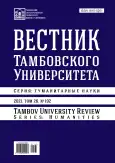Особенности проектно-ориентированного и игрового обучения студентов с использованием среды моделирования SketchUp
- Авторы: Сидляр М.Ю.1, Ковалева О.А.1,2
-
Учреждения:
- ФГБОУ ВО «Тамбовский государственный университет им. Г.Р. Державина»
- ФГБОУ ВО «Тамбовский государственный технический университет»
- Выпуск: Том 26, № 192 (2021)
- Страницы: 148-156
- Раздел: ПЕДАГОГИКА ВЫСШЕЙ ШКОЛЫ
- URL: https://ogarev-online.ru/1810-0201/article/view/298395
- DOI: https://doi.org/10.20310/1810-0201-2021-26-192-148-156
- ID: 298395
Цитировать
Полный текст
Аннотация
Рассмотрены принципы проектной работы студентов в высшем учебном заведении. Приведены примеры обучения студентов по информационным специальностям с применением основ программирования и дизайна в системе высшей школы в странах Европы и Северной Америки. Показаны роли дистанционного, традиционного образования и выбора индивидуальных траекторий в указанном обучении. Особое внимание уделено описанию игровых командных форм обучения при работе в средах трехмерного моделирования и прототипирования. Описаны различные роли преподавателя на каждом этапе во всех игровых проектах на построение сложных конструкторских деталей. Показаны примеры разработанных проектных работ в Тамбовском государственном университете им. Г.Р. Державина при работе с 3D графикой и сведением ее к трехмерной печати, а также встраивание результатов работ в сайты, блоги и другие Веб 2.0 ресурсы. Представлены ключевые этапы проведения командных игр, в том числе выборы капитана команды с использованием психологического ролевого теста Р. Белбин и профессиональных качеств студентов. Подобные работы с успехом можно масштабировать на все направления подготовки университета, а также на профильные направления для студентов средних специальных учебных учреждений. Сделан вывод, что знания по трехмерному моделированию и прототипированию закрепляются в ходе итоговой игровой командной работы по построению сложной конструкции или серии архитектурных сооружений.
Об авторах
М. Ю. Сидляр
ФГБОУ ВО «Тамбовский государственный университет им. Г.Р. Державина»
Email: mihailsidlyar@gmail.com
ORCID iD: 0000-0001-5908-3400
аспирант, старший преподаватель кафедры математического моделирования и информационных технологий
392000, Российская Федерация, г. Тамбов, ул. Интернациональная, 33О. А. Ковалева
ФГБОУ ВО «Тамбовский государственный университет им. Г.Р. Державина»; ФГБОУ ВО «Тамбовский государственный технический университет»
Автор, ответственный за переписку.
Email: solomina-oa@yandex.ru
ORCID iD: 0000-0003-0735-6205
доктор технических наук, доцент, профессор кафедры математического моделирования и информационных технологий
392000, Российская Федерация, г. Тамбов, ул. Советская, 106Список литературы
- Шацкий С.Т. Избранные педагогические сочинения: в 2 т. М.: Педагогика, 1998. Т. 1. 304 с.
- Крупская Н.К. Педагогические сочинения: в 10 т. М., 1958. Т. 3. 798 с.
- Джуринский А.Н. История педагогики. М.: Гум. изд. центр «ВЛАДОС», 1999. 432 с.
- Килпатрик У.Х. Метод проектов. Применение целевой установки в педагогическом процессе. Л., 1925. 44 с.
- Краля Н.А. Метод учебных проектов как средство активизации учебной деятельности учащихся. Омск: Изд-во ОмГУ, 2005. 59 с.
- Сергеев И.С. Как организовать проектную деятельность учащихся. 2-е изд., испр. и доп. М.: АРКТИ, 2005. 80 с.
- Пахомова Н.Ю. Метод учебного проекта в образовательном учреждении. 3-е изд., испр. и доп. М.: АРКТИ, 2005. 112 с.
- Дьюи Д. Школа и общество / пер. с англ. Г.А. Лучинского. М., 1924. 174 с.
- Дреер Р. Применение принципов проектного образования в программах бакалавриата // Высшее образование в России. 2013. № 2. С. 46-49.
- Cho Y., Brown C. Project-based learning in education: integrating business needs and student learning // European Journal of Training and Development. 2013. Vol. 37. № 8. P. 744-765.
- Коллингс Е. Опыт работы американской школы по методу проектов. М.: Новая Москва, 1926. 96 с.
- Сидляр М.Ю. Лабораторная работа «Шахматы» при изучении трехмерного моделирования // Геродот Science. 2018. № 1. С. 71-74.
- Новик Н.В. Информационные технологии как средство повышения эффективности профессиональной подготовки инженера (на материалах дисциплины «инженерная графика») // Общество: социология, психология, педагогика. 2016. № 8. С. 88-90.
- Нартова Л.Г., Гузненков В.Н. Идеи и методы прикладной геометрии и их применение в технике // Международный научно-исследовательский журнал. 2015. № 8-2 (39). С. 46-50.
Дополнительные файлы










